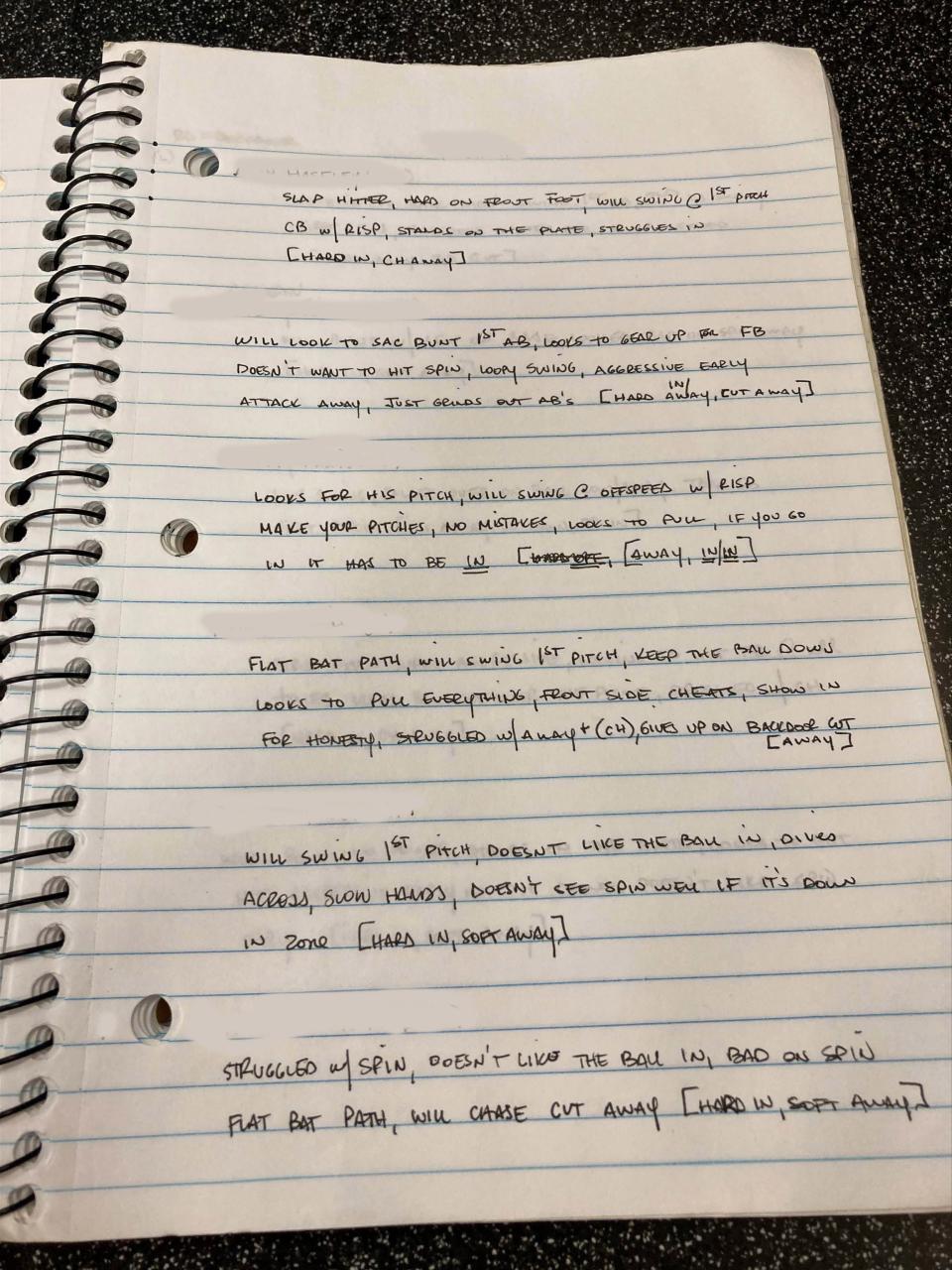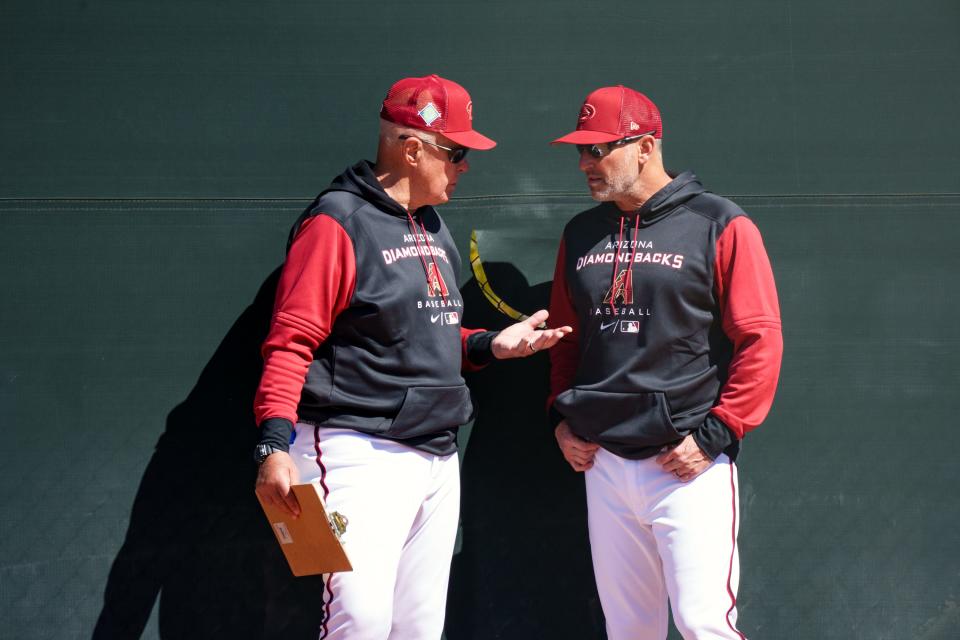Educating an ace: How Zac Gallen has evolved into one of MLB's top pitchers

Diamondbacks right-hander Zac Gallen threw cutters and curveballs to get to two strikes on Philadelphia Phillies slugger Kyle Schwarber in the third inning on Tuesday night, then nodded in agreement with his catcher on the full-count pitch.
Gallen reached back and fired a fastball over the plate, an aggressive pitch to a dangerous hitter. Schwarber hesitated slightly before swinging; he looked surprised to see a fastball. The hesitation cost him. He swung late, striking out, then fired his helmet and shin protector into the ground.
The sequence helps illustrate Gallen’s recent dominance. Not only does he have a deep repertoire of pitches and the ability to command them, Gallen also has an understanding of how best to deploy his arsenal.
Gallen, 27, is fascinated by pitch sequencing, by the chess match of pitching theory. He wants to throw not just the right pitch, but the pitch that will set up the next one and eventually lead to the put-away pitch later in the at-bat. He has spent years studying hitters’ swings and learning what to glean from them, trying not just to find holes but to establish intent. He pores over data and video, devouring the scouting reports the club provides him and augmenting them with his own observations.
In a sense, Gallen has been preparing to do this nearly his entire life. He said video exists of him playing right field at age 5, and while other kids might have been picking flowers in the grass, Gallen was practicing his pitching motion. But in reality he did not truly embrace pitching until he reached college, at which point he embarked on a sort of razor’s edge journey to learn all he could about the craft.
That education stretched through Gallen’s minor league career and, he said, continues still to this day. But it is not a stretch to say, at a time when he is riding a 34 1/3 inning scoreless streak into his start on Sunday against the Milwaukee Brewers, that Gallen has never been better, and his understanding of how to attack hitters is no small reason for that.
Keeping notes on opposing hitters
As a kid growing up in New Jersey, Gallen saw himself more as a baseball player than a pitcher. He was lukewarm on hitting, but he liked playing shortstop and fielding ground balls. He recognized in high school that pitching would be his ticket to the next level, but it was not until he got to the University of North Carolina, where he only pitched, that he threw himself into it.
He got on a throwing program, sticking to it with intent. He focused on refining pitches and tweaking his grips. He started paying more attention to the nuances of his delivery, learning how to be more efficient. And he found himself interested in game planning and learning about opposing hitters.
On a trip back home from college, Gallen worked a baseball camp for little kids at an academy where he used to play. He remembers soft tossing balls for kids to hit and finding himself breaking down their swings.
“I would read their swings as I was flipping them balls and think, ‘Where is the hole in this kid’s swing?' On, like, a 6-year-old,” Gallen said. “As funny as it is, it kind of still played to college baseball when I was there. When you get to the big leagues, the holes are a little harder to find, but they’re still there.”
He started preparing for his starts by jotting down notes on opposing hitters. There was no real data other than a player’s stat line and video was limited to whatever games ESPN3 had carried of UNC’s upcoming opponent. He found what he could and started making observations.
“I remember thinking to myself two things,” recalled North Carolina head coach Scott Forbes, who was the Tar Heels’ pitching coach when Gallen was there. “First, that kid had got it figured out. He wants to be able to coach himself out there, which is what the best do. And then that, one day, he might be a phenomenal coach.”

Gallen still has the 6-inch-by-9-inch notebook, with its faded silver lettering and UNC seal adorning a light blue cover. He took it with him throughout his minor league career, adding a page in advance of every start. Flipping through it this week, he came upon names of players he now faces in the majors and read aloud his words from some five years ago.
“‘Slow bat, wants the ball away, looks bad on change-ups and sliders down,’” Gallen said, sharing the report with the understanding the hitters' names would not be published. “‘Do not do favors with early off speed.’ You know, he’s got the honey hole down and in, but he still to this day kind of gets fooled on fastballs and change-ups. So that still plays.”
Forbes said: “His reports looked like ones that someone who had been coaching for 10 years would do.”
Forbes not only made it a habit to ask Gallen for his opinion of the opposing team’s hitters after his start as a way of preparing for the rest of the series, he later asked if he could photocopy pages out of the notebook, which he has occasionally shown to players who followed Gallen to North Carolina.
Gallen finds an early mentor
In 2018, during his second full season as a professional, Gallen was searching for a reliable curveball. He already had a slider/cutter, but he wanted a curveball to pair with his four-seam fastball. A teammate in the Marlins’ system mentioned something a minor league pitching coach had said about throwing his curveball through a “window.” The cue worked and the pitch finally clicked for Gallen.
The following year, Gallen sought out that pitching coach, Bruce Walton, during spring training in Florida. He wondered what other tidbits Walton might have for him. The ensuing conversations turned out to be more meaningful than Gallen could have imagined.
“I think that’s one of those situations,” Gallen said, “where you’re in the right place at the right time when you need to be there.”
While much of the industry’s focus in recent years when it comes to pitching development is on adding velocity and pitch design, Walton was less interested in mechanics more interested in what goes on between a pitcher’s ears. He found an apt pupil in Gallen.
“I’m a big swing reader,” Walton said. “So we started having conversations.”
Walton began peppering him with questions. If a hitter fouls a ball straight back, Walton asked, what does that tell you as a pitcher? What if he pulls it down the line? What if he is late? What if he takes an inside pitch and grimaces? What if he complains about a call?

“We talked about all that stuff and how you can use that information to attack hitters,” Walton said. “It was reading swings, reading body language. We would talk about that all day long. That’s where our relationship was. He enjoyed talking about it and was really good at it. I feel like I’m pretty good at it, too.”
From Walton, Gallen began to formulate a sort of all-encompassing plan of attack. He learned how one pitch can lead to the next and the next. He learned how his particular pitches can best be sequenced in order to keep a hitter off balance. He learned to think not just what pitch might get a hitter out, but how to get to that pitch, how to disguise that pitch.
“It’s like, OK, this is where I’m going to go if this happens,” Gallen said. “And here’s my backup plan and here’s my backup backup plan.”
Not afraid to change the plan
Facing Schwarber earlier this week, Gallen said the strikeout on the fastball was a case in which he had confidence in his pitch selection. Earlier in the season, in Philadelphia, Gallen watched Schwarber blast one of his change-ups into the seats in right field.
In their first meeting on Tuesday, Gallen thought Schwarber was looking for another change-up. He got him to fly out on a fastball. He said he had a sense Schwarber was again looking for an off-speed pitch in that second at-bat.
“I felt at the time like he probably was sitting on a change-up,” Gallen said. “His swing looked like he was sitting on a change-up. He kind of looked like he was on his front foot, trying to go get pitches. I bet I probably throw more 3-2 change-ups than maybe in any other count. I’m wondering if he was guessing that it would be a 3-2 change-up.”
Gallen admits there are times when he is less certain. He wound up striking out Schwarber again later in the game on a cutter, a pitch catcher Carson Kelly called that Gallen said he had talk himself into throwing. There was a moment in another recent start in which Gallen solicited opinions from teammates during a mound visit on what they thought he should throw.

Hours before a start, Gallen will find a quiet corner of the clubhouse and pore through reports and video with a tablet by his side. He no longer uses notebooks, preferring to keep his notes digitally. If pitching strategist Dan Haren, who devises game plans for the Diamondbacks’ starting pitchers, happens to be in town, the two will go over the plan. But Gallen is not afraid to deviate from it.
“His feel for in-game adjustments is excellent,” Kelly said. “I think that’s another thing that separates him. Instead of just sticking to the game plan the whole time — if it’s working he just sticks to it — but maybe he is feeling a little off with something that day, he goes to something else. He’s able to know what he can and can’t do during the game. And is able to make that adjustment without having a big blow-up inning.”
Said infielder Josh Rojas: “You can have a report, but when you’re dealing with big-league hitters, they can have a different plan or can come up with a new idea. He’s been doing a really good job of seeing that stuff in-game, recognizing it and attacking holes.”
Strom on Gallen's 'chaotic approach'
On Friday, Gallen was named the National League Pitcher of the Month. He allowed three runs in his first start of August, then turned in five consecutive scoreless outings. He is 7 2/3 innings shy of Brandon Webb’s club record of 42 consecutive shutout innings in 2007.
Gallen believes his current run has been aided by pitch selection, but he does not consider it the driving force. More than anything, he said, he has had more pitches working on a given night than he had earlier in the season. When he has a feel for all four of his pitches, he can pitch to hitters’ weaknesses as if he were pitching to his own strengths; they can often be one and the same.
Diamondbacks pitching coach Brent Strom likes to say he has had pitchers with better fastballs, curveballs, sliders or change-ups but has never had a pitcher with a combination of the four as good as Gallen’s.
“It makes it difficult on a hitter when they’re having to say, ‘OK, wow, I’m just not sure,’” Strom said. “Just that little element of doubt allows that fastball to play. They hesitate for a split second. It plays.

“It’s kind of the chaos theory, so to speak. It’s a chaotic approach. They can never settle in and hone in. I think hitters really like to eliminate things and hone in on a location or a pitch and that’s when they do their damage.”
Even now, as he is enjoying the best stretch of his career, Gallen can’t help but think ahead. Haren once told him how many times he had to reinvent himself throughout his career. Gallen has talked to others about this, as well, with several former pitchers telling him the same things.
“They were saying like almost every four years you have to evolve into something else,” Gallen said. “Then you have to do it again four years after that. Four years isn’t exact, but around that time.”
It makes him think about the future every time he plays catch between starts.
“In the back of my head, it’s like, what if I could work on a sinker just two times every time I pick up a ball?” Gallen said. “Maybe that’s just two throws, but in four years what do those two throws every day add up to? Maybe then I’ll need to start learning how to run a ball in there and I’ve kind of built it up. Just having stuff in your back pocket, it can’t hurt.”
Reach Piecoro at (602) 444-8680 or nick.piecoro@arizonarepublic.com. Follow him on Twitter @nickpiecoro.
This article originally appeared on Arizona Republic: Secret to Diamondbacks pitcher's streak: a little bit of 'chaos theory'

